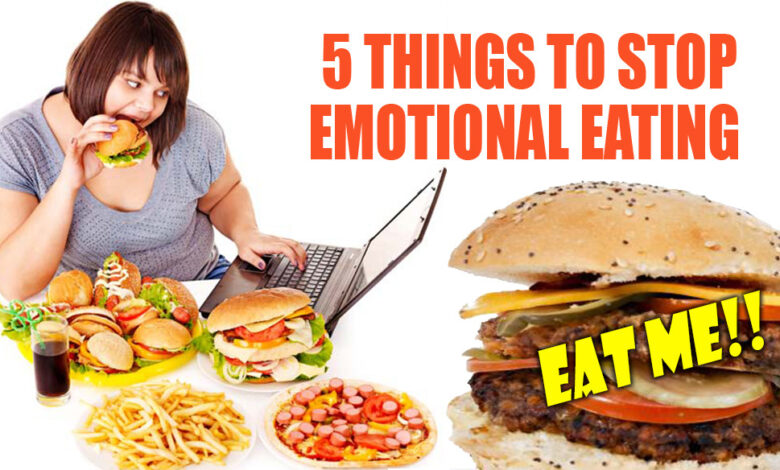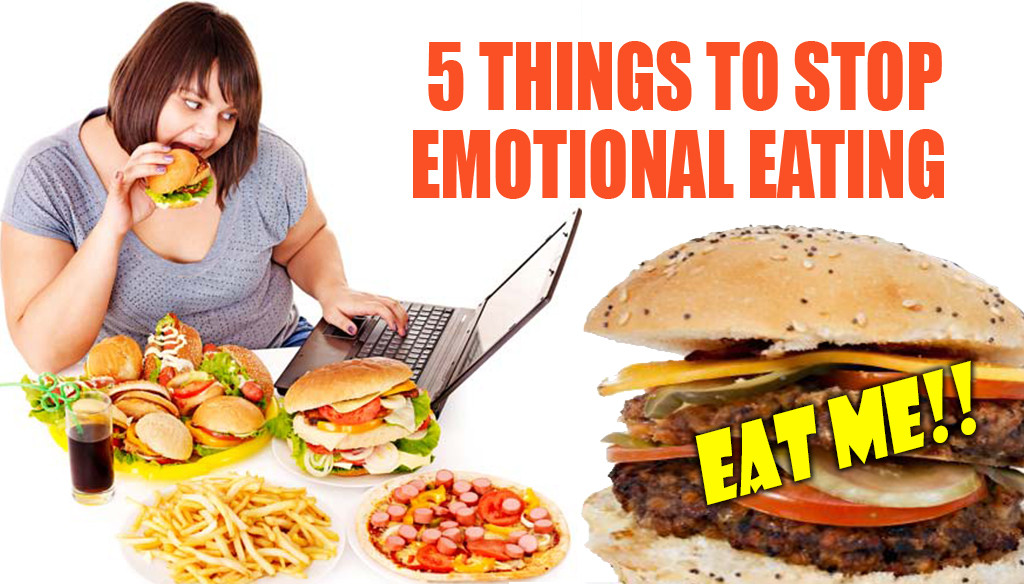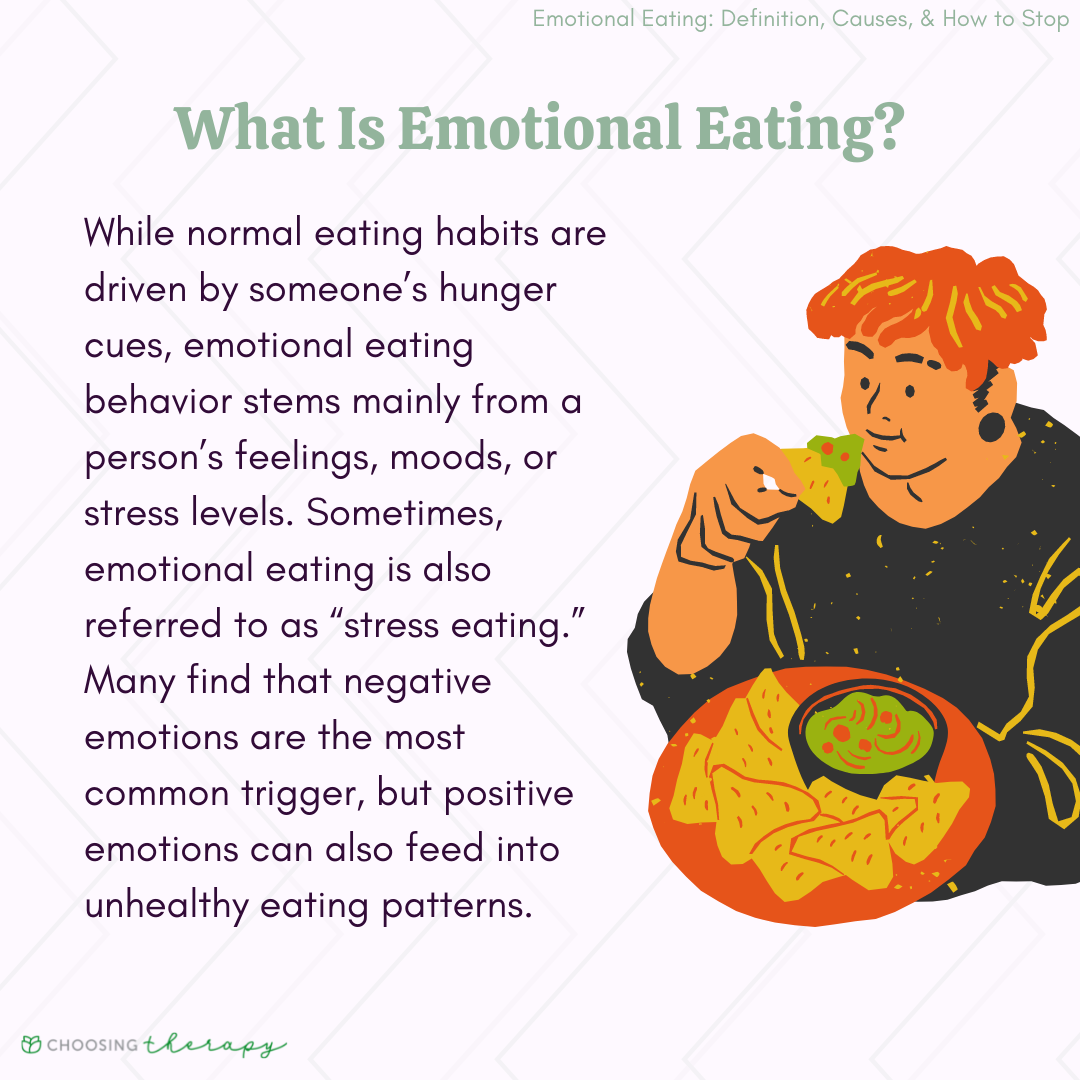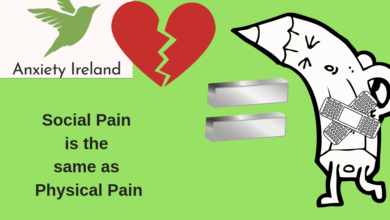
What can I do to stop emotional eating? This isn’t just about willpower; it’s about understanding the underlying emotional needs driving your cravings. We’ll explore the triggers, the physiological responses, and the connection between unmet needs and food. This journey reveals practical strategies to manage stress, build emotional resilience, and cultivate a healthier relationship with yourself and food.
We’ll delve into the different types of emotional eating, like stress eating and boredom eating, and how they relate to your emotional state. Understanding these triggers is the first step to breaking free from the cycle. We’ll also discuss the importance of a supportive network, healthy coping mechanisms, and dietary strategies for emotional regulation. This comprehensive approach will help you identify and address the root causes of emotional eating, empowering you to build lasting change.
Understanding Emotional Eating
Emotional eating is a common coping mechanism, often used to soothe negative emotions. It’s distinct from physical hunger, which is driven by the body’s need for nutrients. Emotional eaters are not necessarily driven by a lack of food, but rather by a need to manage uncomfortable feelings. Instead of addressing the underlying emotion, they turn to food as a temporary distraction or solution.Emotional eating is a complex issue, deeply rooted in learned behaviors and emotional patterns.
Understanding the triggers, physiological responses, and different types of emotional eating is crucial for developing healthy coping mechanisms.
Figuring out how to stop emotional eating can be tricky, especially when dealing with hormonal shifts. One surprising way to help manage those cravings is through exercise. For example, incorporating more walking into your routine, like the methods detailed in ways to ease menopause symptoms with walking , can actually help regulate mood and reduce emotional triggers.
Ultimately, finding healthy coping mechanisms, like regular physical activity, is key to overcoming emotional eating habits.
Defining Emotional Eating
Emotional eating is the act of consuming food in response to emotions other than physical hunger. It’s a learned behavior where individuals turn to food as a way to manage stress, sadness, boredom, or other difficult feelings. Unlike physical hunger, emotional eating is driven by a need to regulate emotions rather than a physiological need for nutrients. This emotional response to food differs significantly from a response to physical hunger, which triggers specific bodily sensations like stomach rumbling and an increase in appetite.
Common Triggers of Emotional Eating
Numerous factors can trigger emotional eating. Stressful situations, whether personal or professional, often lead to increased cravings and consumption of food. Relationship conflicts, financial worries, or major life changes can all contribute to emotional eating. Boredom, loneliness, or feeling unengaged in life are also frequent triggers. A lack of emotional regulation skills can make it harder to manage these feelings without resorting to food.
Physiological Responses to Emotional Eating
Emotional eating often elicits a complex physiological response. The release of hormones, such as cortisol (stress hormone), can trigger increased appetite and cravings. These cravings are often accompanied by a lack of awareness regarding the emotional trigger and the need to manage the underlying emotion. The temporary relief provided by food can reinforce the emotional eating cycle.
This cycle is often repetitive and difficult to break without understanding the root causes of emotional eating.
Examples of Emotional Eating Situations
Imagine a person experiencing a particularly stressful work week. The mounting deadlines and pressure lead to feelings of anxiety and frustration. To cope, they might turn to comfort foods, overeating sugary snacks, or larger portions of meals, even if they aren’t physically hungry. Another example might be someone feeling lonely after a breakup. To soothe the sadness, they might binge on ice cream or other comforting foods.
These instances illustrate the link between emotional states and food consumption.
Types of Emotional Eating
| Type | Description | Examples |
|---|---|---|
| Stress Eating | Eating in response to stress | Overeating during a stressful work week, binging after a fight, consuming large portions of food when feeling overwhelmed. |
| Boredom Eating | Eating when bored or unengaged | Snacking while watching TV, eating out of habit, or mindless consumption when feeling under-stimulated. |
| Sadness Eating | Eating to cope with sadness or loneliness | Comfort eating after a breakup, binge eating when feeling down, using food to fill an emotional void. |
Identifying Emotional Needs
Emotional eating often stems from an unmet need, rather than simply a craving. Understanding these underlying emotions is crucial for developing healthier coping mechanisms. We’re not necessarily bad for feeling certain emotions; rather, we need to acknowledge them and find appropriate ways to address them. Identifying these needs can pave the way for lasting change.Unmet emotional needs often manifest as a desire for comfort, validation, security, or attention.
These needs, when not met in healthy ways, can lead to emotional eating as a temporary solution. Acknowledging these needs, recognizing their significance, and finding healthier ways to satisfy them are key steps toward breaking the cycle of emotional eating. The crucial step is not to suppress these feelings, but to understand and address them constructively.
Underlying Emotional Needs
Emotional eating is often a coping mechanism for underlying emotional needs that are not being met in other ways. These needs can include a desire for validation, security, attention, or even a sense of belonging. Identifying and acknowledging these unmet needs is the first step toward developing healthier coping strategies. Addressing the underlying emotional needs, rather than just focusing on the eating behavior, is essential for long-term change.
Connection Between Unmet Needs and Emotional Eating
A strong correlation exists between unmet emotional needs and emotional eating. When we lack fulfillment in areas like validation, security, or attention, we may turn to food as a temporary source of comfort or satisfaction. This is not a sign of weakness but rather a response to a lack of alternative coping mechanisms. Understanding this connection helps us recognize the root cause of emotional eating, paving the way for healthier solutions.
Importance of Recognizing and Validating Needs
Recognizing and validating these emotional needs is paramount in breaking the cycle of emotional eating. Denying or ignoring these feelings only reinforces the need to seek comfort elsewhere, often in the form of food. Validating these needs allows us to address them constructively, fostering a greater understanding of ourselves and our emotional landscape. This self-awareness allows us to find more constructive ways to meet those needs.
Connecting Emotional Needs with Healthy Outlets, What can i do to stop emotional eating
Instead of relying on food to address emotional needs, we can develop healthier outlets for dealing with these feelings. This could involve talking to a trusted friend or family member, journaling, engaging in physical activity, practicing mindfulness, or pursuing hobbies. These healthy outlets provide alternative ways to process and address the underlying emotions without resorting to emotional eating.
Diversifying our coping mechanisms is key to managing emotions effectively.
Table Demonstrating Emotional Needs and Coping Mechanisms
| Emotional Need | Possible Coping Mechanism (Emotional Eating) | Healthy Alternative |
|---|---|---|
| Validation | Comfort eating | Seeking support from friends, journaling, expressing needs directly |
| Security | Binging on sweets | Engaging in relaxing activities, practicing mindfulness, building a support system |
| Attention | Overeating | Seeking social interaction, pursuing hobbies, joining a group or club |
Developing Healthy Coping Mechanisms
Breaking free from emotional eating requires more than just identifying your triggers. It demands the development of robust coping mechanisms that allow you to navigate difficult emotions without turning to food. This involves learning to manage stress, cultivate emotional resilience, and practice mindfulness. Understanding these strategies will empower you to create a healthier relationship with food and your emotions.Learning to manage stress and difficult emotions constructively is crucial for overcoming emotional eating.
Healthy coping mechanisms provide alternative outlets for expressing and processing these feelings, preventing them from escalating into cravings for food. Mindfulness, in particular, plays a pivotal role in this process.
Stress Management Strategies
Effective stress management is key to preventing emotional eating. Chronic stress can weaken the ability to regulate emotions, leading to a greater likelihood of turning to food for comfort. A variety of methods can be used to manage stress. These include:
- Physical Activity: Engaging in regular exercise, whether it’s a brisk walk, a yoga session, or a gym workout, releases endorphins, which have mood-boosting effects. Physical activity provides a healthy outlet for pent-up energy and stress.
- Deep Breathing Exercises: These exercises help to calm the nervous system and reduce feelings of anxiety. Simple techniques like box breathing or diaphragmatic breathing can be practiced anywhere, anytime.
- Mindfulness and Meditation: Mindfulness techniques, such as focusing on the present moment, can help detach from stressful thoughts and feelings. Meditation trains the mind to observe thoughts without judgment, fostering emotional regulation.
- Time Management and Organization: Effective time management helps to reduce feelings of overwhelm and pressure. Creating schedules, prioritizing tasks, and breaking down large projects into smaller steps can significantly alleviate stress.
- Social Support: Talking to trusted friends, family members, or a therapist can provide emotional support and perspective during stressful times. Sharing your feelings and concerns can be incredibly helpful.
Mindfulness Techniques for Emotional Eating
Mindfulness is a powerful tool in the fight against emotional eating. By focusing on the present moment, mindfulness techniques can help you become more aware of your emotional responses without judgment. This awareness can help you identify triggers and develop healthier coping mechanisms.
- Mindful Eating: Pay attention to the physical sensations of eating, the taste, texture, and smell of food. This mindful awareness can help you recognize when you’re truly hungry versus when you’re eating out of emotional distress.
- Body Scan Meditation: This technique involves bringing awareness to different parts of your body, noticing any tension or discomfort. This practice can help you connect with your physical sensations and regulate your emotional response to stress.
- Mindful Observation of Thoughts and Feelings: Observe your thoughts and feelings without judgment. Recognize that thoughts and feelings are temporary and don’t have to control your actions.
Building Emotional Resilience
Emotional resilience is the ability to bounce back from adversity and stress. Building emotional resilience is crucial for managing emotional eating. It involves developing coping strategies, seeking support, and fostering self-compassion.
- Identifying and Challenging Negative Thoughts: Recognizing negative self-talk and challenging those thoughts with more balanced perspectives can strengthen emotional resilience.
- Developing Self-Compassion: Treating yourself with kindness and understanding, especially during difficult times, is essential for emotional well-being. Acknowledge your emotions and allow yourself to experience them without judgment.
- Setting Healthy Boundaries: Learning to set healthy boundaries in relationships and with responsibilities can reduce stress and promote a sense of control over your life.
Developing Healthy Coping Mechanisms: A Step-by-Step Guide
- Identify your triggers: Keep a journal to track situations, emotions, and food choices.
- Develop healthy alternatives: Create a list of activities that can help you manage stress without food, such as exercise, meditation, or spending time in nature.
- Practice mindfulness techniques: Engage in mindfulness exercises like deep breathing or body scans to cultivate awareness of your emotions and physical sensations.
- Build a support system: Connect with friends, family, or a therapist to discuss your struggles and receive emotional support.
- Reward yourself for progress: Acknowledge and celebrate your efforts to develop healthy coping mechanisms. This positive reinforcement will motivate you to continue.
Recognizing and Managing Triggers
Identifying and managing triggers that lead to emotional eating is a critical step in overcoming this behavior. Understanding your triggers allows you to develop proactive strategies for managing them.
Figuring out how to stop emotional eating can feel overwhelming, but it’s definitely doable. One key strategy is to identify your triggers – are you stressed, bored, or sad when you reach for that extra cookie? Knowing your triggers helps you understand the underlying emotion driving the eating. It’s important to find healthy ways to cope with these emotions, just like millions of families are anxiously awaiting the fate of their favorite show, millions of families wait to see if Chip will continue.
Focusing on healthy alternatives like exercise, mindfulness, or talking to a friend can help distract you from the urge to eat when you’re feeling down. Ultimately, emotional eating is a learned behavior, so it can be unlearned with the right strategies and support.
- Emotional Triggers: Stress, sadness, anger, loneliness, and boredom can all be triggers. Recognizing the emotional triggers associated with your emotional eating can help you develop appropriate coping strategies.
- Environmental Triggers: Certain situations, places, or smells can also trigger emotional eating. Identify and avoid these environmental triggers when possible. For example, if you tend to eat when watching TV, consider switching activities.
- Social Triggers: Social events or gatherings can sometimes trigger emotional eating. Developing strategies for navigating these situations without relying on food is crucial.
Building a Support System

Overcoming emotional eating isn’t a solo journey. A strong support system can provide the encouragement, accountability, and understanding needed to navigate the challenges and build lasting healthy habits. This support network can offer a crucial buffer against emotional triggers and provide a safety net during difficult times.A supportive network plays a vital role in fostering emotional resilience and creating a sense of belonging.
It can help you develop coping strategies that work for you and provide a sounding board when you’re feeling overwhelmed or struggling. This system also acts as a powerful motivator, reminding you of your goals and reinforcing your commitment to change.
Identifying and Cultivating Supportive Relationships
Healthy relationships are built on mutual respect, trust, and open communication. Identifying individuals who genuinely care about your well-being and are supportive of your journey is crucial. Look for people who listen without judgment, offer encouragement, and celebrate your progress, even the small victories.Cultivating these relationships involves active effort. Make time for meaningful connections, both with existing friends and family, and by seeking out new people who share your values and interests.
Honesty and vulnerability are key. Sharing your struggles and successes with trusted individuals can strengthen your bond and foster mutual understanding. This trust is essential for receiving genuine support and encouragement.
Figuring out how to stop emotional eating can be tough, but it’s definitely achievable. One aspect that often gets overlooked is the potential connection between emotional eating and underlying health issues, like respiratory conditions such as primary and secondary emphysema. While these conditions aren’t the cause of emotional eating, understanding how they might impact your body and mood is crucial for developing a holistic approach to stopping emotional eating altogether.
The Role of Therapy or Counseling
Therapy or counseling can be a powerful tool in addressing emotional eating. A therapist can provide a safe and confidential space to explore the underlying emotional issues that contribute to your eating habits. They can help you identify and challenge negative thought patterns, develop healthier coping mechanisms, and create a personalized plan for change.Therapists can help you process difficult emotions and develop emotional regulation skills, which are crucial for preventing emotional eating.
They can also teach you how to identify and manage triggers and cravings, equipping you with the tools needed to navigate challenging situations. Working with a therapist offers a structured and supportive environment for addressing the root causes of your emotional eating.
Examples of Support Groups and Online Communities
Support groups and online communities can offer a sense of belonging and shared experience. They provide a platform to connect with others who understand the challenges of emotional eating and offer support and encouragement.Examples include online forums, social media groups, and in-person support groups specifically focused on emotional eating. These communities can provide a space to share experiences, strategies, and encouragement.
Sharing experiences and learning from others can foster a sense of camaraderie and motivation.
Creating a Support Network
Creating a support network involves identifying trusted individuals and setting boundaries. Start by listing individuals who offer support and encouragement. These could be family members, friends, colleagues, or even online community members.Clearly defining your boundaries is equally important. Communicate your needs and limits to those in your support network. This ensures that you’re not taking on more than you can handle and that others are understanding of your needs and commitments to your recovery journey.
These boundaries can protect your emotional well-being and prevent burnout.
Dietary Strategies for Emotional Eating: What Can I Do To Stop Emotional Eating
Understanding the connection between our emotions and food choices is crucial in managing emotional eating. Dietary strategies provide tangible tools to regulate emotional responses to food, fostering a healthier relationship with nourishment. A balanced approach to nutrition, coupled with mindful eating practices, can significantly impact our emotional well-being and reduce reliance on food as an emotional crutch.By implementing these strategies, we can shift from emotional eating to a more mindful and fulfilling relationship with food, empowering us to address emotional needs in healthier ways.
Balanced Nutrition and Emotional Eating
Balanced nutrition plays a significant role in managing emotional eating. When our bodies lack essential nutrients, we may experience mood swings, irritability, and cravings. A diet rich in fruits, vegetables, lean proteins, and whole grains provides the necessary vitamins, minerals, and fiber to support overall well-being, including emotional stability. Regular consumption of these foods helps to regulate blood sugar levels, which can impact mood swings and cravings.
Mindful Eating Practices
Mindful eating is a powerful technique for reducing emotional eating. It involves paying close attention to the physical sensations of hunger and fullness, as well as the emotional cues that trigger food cravings. By slowing down during meals and focusing on the taste, texture, and smell of food, we become more attuned to our body’s signals. This awareness can help us distinguish between physical hunger and emotional cravings, leading to healthier food choices.
Practicing mindful eating encourages a non-judgmental approach to food, promoting a healthier relationship with nourishment.
Hydration and Emotional Regulation
Adequate hydration is often overlooked in discussions about emotional eating, yet it plays a crucial role in emotional regulation. Dehydration can lead to fatigue, headaches, and irritability, which can increase the likelihood of emotional eating. Drinking enough water throughout the day helps maintain energy levels, supports cognitive function, and promotes feelings of well-being. Maintaining consistent hydration levels can create a buffer against emotional responses to food.
Sample Meal Plan
This sample meal plan exemplifies balanced nutrition and mindful eating principles. It emphasizes whole foods and portion control, encouraging mindful engagement with each meal.
| Meal | Description | Mindful Eating Considerations |
|---|---|---|
| Breakfast | Oatmeal with berries and nuts, a glass of water | Savor the taste and texture of the oatmeal, notice the aroma of the berries and nuts. Pay attention to your hunger and fullness cues. |
| Lunch | Large salad with grilled chicken or fish, a side of quinoa | Appreciate the colors and textures of the salad. Chew slowly and fully appreciate the flavors. |
| Dinner | Baked salmon with roasted vegetables (broccoli, carrots, sweet potatoes), a small portion of brown rice | Focus on the aroma of the salmon and vegetables. Notice the warmth of the food and the satisfying fullness. |
| Snacks | Fruits (apple, banana), a handful of almonds, a cup of herbal tea | Pay attention to the taste and texture of the fruits. Notice the crunch of the almonds. Savor the taste of the herbal tea. |
Addressing Underlying Issues
Emotional eating often stems from deeper, underlying issues. Simply addressing the external behavior of reaching for food when feeling overwhelmed won’t always resolve the problem. Identifying and tackling these root causes is crucial for long-term change. This involves recognizing potential psychological factors, the impact of trauma, and developing strategies for proactively managing mental health concerns.Understanding the root causes of emotional eating is key to developing sustainable coping mechanisms.
By addressing the emotional needs driving these behaviors, individuals can move towards healthier relationships with food and themselves.
Identifying Potential Psychological Issues
Many psychological factors can contribute to emotional eating. These can include past traumas, unresolved grief, stress, anxiety, or depression. Recognizing these factors allows individuals to address the underlying cause, rather than just the symptom. Identifying these issues is the first step towards effective treatment and recovery.
The Role of Trauma in Emotional Eating
Trauma, in its various forms, can significantly impact an individual’s emotional well-being and contribute to emotional eating. Trauma can lead to a dysregulation of the body’s stress response, making individuals more susceptible to emotional eating as a way to cope with overwhelming emotions. The experience of trauma can create a profound and lasting impact on an individual’s life, influencing their behaviors and reactions to stressful situations, often manifesting as emotional eating.
Addressing Potential Mental Health Concerns
Addressing mental health concerns is crucial for effectively managing emotional eating. This involves recognizing the signs and symptoms of various mental health conditions and seeking professional help when needed. Early intervention and treatment can lead to significant improvements in emotional well-being and reduce reliance on emotional eating as a coping mechanism.
Strategies for Seeking Professional Help
Seeking professional help is a courageous step towards managing emotional eating. A therapist or counselor can provide support and guidance in identifying underlying issues, developing healthy coping mechanisms, and navigating challenging emotions. It’s important to find a professional who specializes in treating eating disorders or emotional eating. There are many resources available, including online directories, recommendations from friends or family, and mental health clinics.
Don’t hesitate to reach out for help if you need it. A qualified mental health professional can provide personalized strategies for managing underlying psychological issues.
Summary of Mental Health Conditions and Emotional Eating
| Mental Health Condition | Potential Link to Emotional Eating | Example Symptoms |
|---|---|---|
| Depression | Using food to cope with sadness and low mood, potentially leading to comfort eating. | Loss of interest, fatigue, feelings of worthlessness, changes in appetite. |
| Anxiety | Eating as a coping mechanism for fear and worry, possibly leading to binge eating or restrictive eating patterns. | Excessive worry, restlessness, physical symptoms like stomach aches or headaches, avoidance behaviors. |
| Trauma | Using food to regulate overwhelming emotions, potentially leading to emotional dysregulation. | Flashbacks, nightmares, avoidance behaviors, difficulty concentrating, irritability, hypervigilance. |
Closing Notes

Ultimately, stopping emotional eating is a journey of self-discovery and empowerment. By understanding the root causes, developing healthy coping mechanisms, and building a strong support system, you can reclaim control over your relationship with food and cultivate a healthier, more fulfilling life. This guide provides a roadmap for your journey, from identifying triggers to building resilience and seeking professional support.
Remember, you’re not alone, and lasting change is possible.





